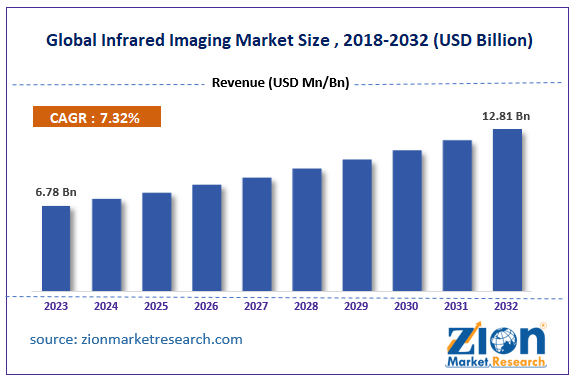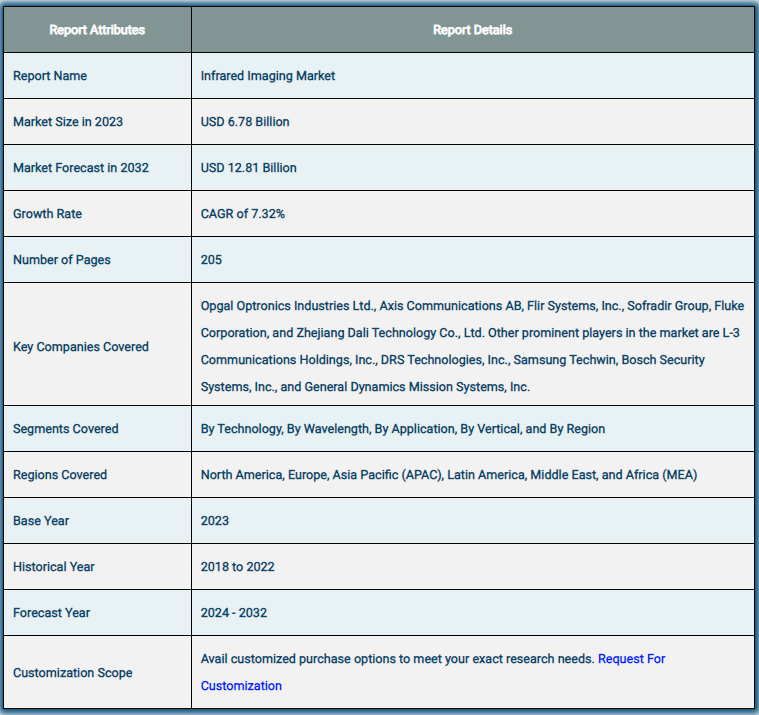🌏Infrared Imaging Market Trend, Share, Growth, Size, Analysis, and Forecast (2024–2032)

The size of the worldwide infrared imaging market was estimated to have generated earnings of around USD 6.78 billion in 2023 and is expected to generate revenue of roughly USD 12.81 billion by 2032. The market is expected to grow at a compound annual growth rate of roughly 7.32% between 2024 and 2032.
✈👉Get a Free Sample: 🚀https://www.zionmarketresearch.com/sample/infrared-imaging-market
Introduction
Infrared imaging technology has emerged as a crucial tool in a wide range of applications, from military and defense to medical diagnostics, industrial inspection, and beyond. The ability of infrared imaging to detect and visualize thermal differences has made it indispensable for both commercial and scientific uses. This article delves into the current state of the infrared imaging market, highlighting key growth drivers, challenges, market segmentation, and future opportunities.

Overview of the Global Infrared Imaging Market
The process of taking invisible infrared pictures and turning them into visible images is known as infrared imaging. The human eye cannot see infrared light; instead, infrared cameras and imagers are required. These gadgets can function without the need for visible light thanks to unique sensors. The targeted objects in the infrared imaging approach release radiations. The imaging equipment are equipped with LEDs for lighting and infrared illuminator lasers. Thermal infrared imagers pick up the infrared radiation that warm objects emit. By converting infrared signals into electric signals, these sensor arrays create images. When epidemics like the swine flu, severe acute respiratory syndrome, and Ebola break out, airports employ infrared imaging a lot to identify and screen travelers who have elevated body temperatures. In cars, infrared imaging provides a night vision option.
Infrared imaging uses infrared radiation to create images, which allow for the detection of temperature variations invisible to the naked eye. This technology is primarily used for thermal imaging, night vision, surveillance, and condition monitoring, making it essential across multiple industries such as defense, automotive, aerospace, healthcare, and industrial manufacturing.

The global infrared imaging market has been experiencing substantial growth, driven by advancements in sensor technology, increasing demand for automation, and rising applications in industries like security and medical diagnostics. The growth of smart technologies, such as smart homes and connected devices, has further expanded the market scope, allowing for broader adoption of infrared technology.
Growth Factors for the Global Infrared Imaging Market Due to the growing acceptance of infrared imaging by unexplored applications, the market for this technology is expected to rise at a faster rate in the near future. The military uses infrared cameras, which is expected to drive market expansion. New avenues for market expansion are being created by developments in infrared imaging technology and the accessibility of cheaply priced infrared cameras. Applications for infrared cameras are growing in popularity, including industrial imaging, security, and firefighting.
✈👉Directly Purchase a copy of the report with TOC: 🚀https://www.zionmarketresearch.com/toc/infrared-imaging-market
Market for Infrared Imaging: Report Scope

Segmentation of the Global Infrared Imaging Market
There are four main classifications for the worldwide infrared imaging market: wavelength, component, application, and technology. The market is divided into four segments based on wavelength: far wave infrared imaging (FWIR), long wave infrared imaging (LWIR), medium wave infrared imaging (MWIR), and shortwave infrared imaging (SWIR). The component section is separated into categories such as infrared sensors, infrared lens systems, and detectors. The global infrared imaging market is divided into several segments based on the applications they are used for: aerospace and defense, medical, consumer electronics, firefighting, automotive, industrial, and surveillance. There are two categories for the technology segment: cooled and uncooled.
Global Market for Infrared Imaging: Regional Evaluation
Asia Pacific leads the infrared imaging market because of growing activity in the oil and gas, automotive, and other applications sectors. Because of its large market share, the infrared imaging market in North America is expected to develop significantly in the near future. Continuous technology developments are expected to propel the North American market in nations like Mexico, the United States, and Canada. Leading European companies’ growing propensity toward infrared imaging is predicted to rise at the fastest rate.
Key Market Segments
The infrared imaging market can be segmented into various categories based on technology, application, wavelength, and region.
- By Technology:
- By Application:
- By Wavelength:
- By Region:
Market Drivers
Several factors are propelling the growth of the infrared imaging market:
- Increased Demand for Surveillance and Security: Governments, militaries, and commercial sectors are increasingly adopting infrared imaging for enhanced surveillance and security, particularly in low-visibility conditions. Infrared cameras and sensors are widely used in night vision systems, perimeter security, and border control.
- Advancements in Infrared Technology: Recent innovations in infrared sensors and the miniaturization of devices have enabled the development of more affordable, compact, and efficient infrared imaging systems. These advancements are allowing broader access to the technology in consumer electronics, automotive applications, and industrial systems.
- Growing Applications in Healthcare: Infrared imaging is increasingly used in the medical field for non-invasive diagnostic procedures, such as detecting tumors, vascular disorders, and monitoring body temperature. The COVID-19 pandemic heightened the demand for infrared thermography to monitor elevated body temperatures, which further fueled market growth.
- Rising Industrial Automation: The adoption of infrared imaging for industrial automation and inspection is on the rise. Industries such as manufacturing, energy, and oil & gas use infrared cameras for predictive maintenance, detecting mechanical anomalies, and ensuring equipment safety.
- Environmental Monitoring: Infrared imaging plays a crucial role in monitoring environmental changes, such as forest fires, climate change, and wildlife studies. Its ability to detect heat signatures at a distance makes it an important tool for environmental protection.
Challenges in the Market
Despite the promising growth, the infrared imaging market faces several challenges:
- High Costs: The cost of infrared cameras, particularly those using cooled sensors, remains high. Although uncooled cameras are becoming more affordable, the cost of acquiring and maintaining high-end infrared systems can be prohibitive for small-scale applications and consumers.
- Technological Limitations: Infrared imaging technology, especially for long-range and high-resolution imaging, faces limitations in terms of sensitivity and accuracy in certain environments. Infrared cameras may also be affected by factors such as fog, dust, or extreme weather conditions, which can impact performance.
- Data Interpretation Complexity: Interpreting infrared images can be complex and often requires specialized training. The difficulty of distinguishing between different thermal patterns and understanding what they represent can lead to misinterpretation, especially in critical applications such as medical diagnostics and industrial inspections.
Emerging Trends
Several key trends are shaping the infrared imaging market and influencing its future trajectory:
- Miniaturization of Infrared Sensors: The miniaturization of infrared sensors is enabling the integration of infrared imaging technology into smaller devices such as smartphones, drones, and wearable devices. This trend is expected to drive further adoption of infrared imaging in consumer electronics and portable applications.
- Increasing Use of SWIR Imaging: Short-wave infrared (SWIR) imaging is gaining popularity due to its ability to provide clearer images in challenging environments, such as fog, smoke, or dust. SWIR sensors can detect wavelengths between visible light and infrared, making them ideal for military, industrial, and medical applications.
- Automotive Applications: The growing adoption of autonomous vehicles and advanced driver assistance systems (ADAS) is boosting the demand for infrared imaging. Thermal cameras are used for enhanced night vision, obstacle detection, and pedestrian safety in self-driving cars.
- AI Integration for Image Analysis: The integration of artificial intelligence (AI) with infrared imaging systems is revolutionizing image analysis and interpretation. AI-powered thermal imaging solutions are being used for predictive maintenance, surveillance, and real-time diagnostics, reducing human error and improving operational efficiency.
- Energy Efficiency and Smart Buildings: Infrared imaging is increasingly used in the construction and energy sectors for energy audits, detecting heat leaks, and ensuring the efficiency of HVAC systems. Smart buildings equipped with infrared imaging technology can improve energy consumption and sustainability.
Competitive Landscape
The infrared imaging market is highly competitive, with several key players dominating the industry. Major players include:
- FLIR Systems, Inc.
- Fluke Corporation
- Leonardo DRS
- Axis Communications AB
- Raytheon Technologies Corporation
- L3Harris Technologies, Inc.
- Seek Thermal, Inc.
- Opgal Optronic Industries Ltd.
- Testo SE & Co. KGaA
- Xenics NV
These companies are focusing on product innovations, strategic partnerships, mergers and acquisitions, and expanding their geographical reach to strengthen their market presence.
Future Outlook
The future of the infrared imaging market looks promising, with continuous advancements in technology and an expanding range of applications. The increasing adoption of infrared imaging in emerging industries such as autonomous vehicles, environmental monitoring, and smart cities is expected to drive market growth in the coming years.
In particular, the demand for uncooled infrared imaging systems is likely to rise due to their affordability and ease of use, while developments in AI and machine learning will further enhance the capabilities of infrared imaging solutions. The ongoing development of next-generation infrared sensors, with higher sensitivity and improved resolution, will open new opportunities for manufacturers and service providers.
Conclusion
The infrared imaging market is positioned for significant growth, driven by its diverse applications across multiple industries and the increasing demand for advanced surveillance, diagnostic, and monitoring technologies. While challenges such as high costs and technological limitations persist, innovations in sensor technology, AI integration, and miniaturization are likely to overcome these barriers and shape the future of the infrared imaging industry.
With the continued adoption of infrared imaging in emerging sectors such as autonomous vehicles, healthcare, and environmental monitoring, the market is expected to maintain a positive growth trajectory, offering lucrative opportunities for businesses and investors alike.
✈👉Enquiry for buying: 🚀https://www.zionmarketresearch.com/inquiry/infrared-imaging-market
Browse other trend reports:
Drug Development Services Market
Construction Waste Recycling Market
Complex Inorganic Color Pigments Market
Contact Us:
Zion Market Research212
USA/Canada Toll Free: 1 (855) 465–4651
Newark: 1 (302) 444–016611\
Web: https://www.zionmarketresearch.com/
Blog: https://zmrblog.com/

Comments
Post a Comment